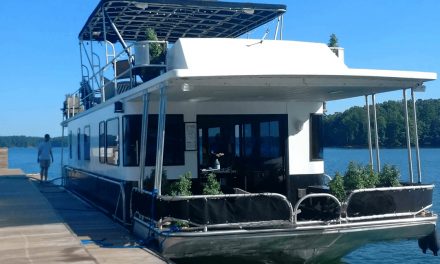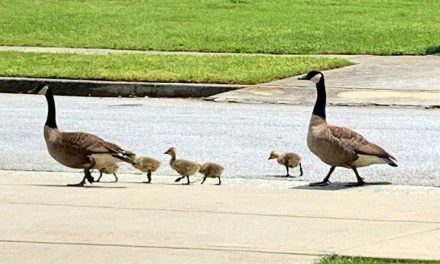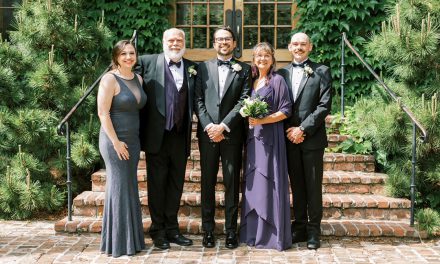The sailing adventure for a group of 9- and 10-year-olds on a sunny Sunday afternoon wasn’t just a joy ride. These students were on a mission to understand what makes a sailboat go.
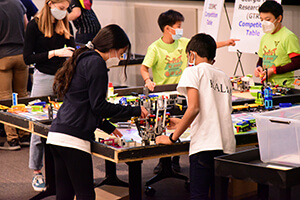
Students compete in the FIRST LEGO League robotics challenge state championship
The youngsters, members of the Georgia Championship Robotic Team from Sharon Elementary School in Suwanee, earned the Georgia State FIRST LEGO League First Place Champions Award at Georgia Tech earlier this year, beating out more than 385 teams. As such, The Sharon Robo Knights SRK X-Wings Robotics Team is headed to the International FIRST LEGO League Razorback Open Invitational at the University of Arkansas.
“The international competition this year focused on solving a real-world challenge using robotics and technology, helping elementary and middle school students embrace their STEM skills,” said Wendy Wing, gifted education teacher and coach for the 10-person team of 4th- and 5th-graders. “We’ve been working on our project of the X-Wing kite sail all year and were thrilled when our team won the state championship.”
STEM stands for Science, Technology, Engineering and Math, and it’s the hottest curricula in education today, often starting in preschool. Statistics show that STEM education has been giving high-school and college graduates more than a leg up in landing challenging and high-paying jobs. When the process is interactive and hands-on, the success rate is even greater.
An afternoon on the water
The Cargo Connect challenge, created by FIRST LEGO League as the 2021-2022 project, required teams to focus on robotics, technology and physical principles to move cargo globally. For the 10 4th and 5th -graders from Sharon Elementary, sailing held the key to understanding how their project would work.
Each group of competitors around the world received access to the same resources, materials, rulebooks and instructions. The outcome of how each team used these resources would determine the champions.
“While our students were doing their research about how cargo is moved, then designing, building and programming their robotics, other teams were at work as well,” Wing said.
“We turned to numerous resources in addition to those provided, including reading about ships, economics, ocean ecology and marine life. We have worked with many experts from the International Maritime Organization, engineers, and CEO’s of manufacturing companies to improve our prototype of our X-Wing kite sail that can be retrofitted onto cargo ships.”
The book, Song for a Whale, provided inspiration to make ocean-going cargo vessels quieter and more environmentally friendly. They brainstormed ideas and decided to take their work back to basic physics principles used by early explorers who crossed vast oceans using nothing but wind power.
“As we worked through the program, we found out that 90 percent of the world’s cargo today is transported on the ocean,” Wing said. “That concerned us because of the risk of environmental pollution but also because of the harm it is doing to marine life and the sea’s ecology, particularly whales and their breeding. Song for a Whale really touched our students’ hearts. It’s the story of a young deaf girl and a whale, a tale of survival and hope. It really brought the issues home to our students.”
Wing’s students proposed a solution that would address the environmental harm of fuel-driven ships, the high costs of fuel as well as the noise that affected the whales,” she said. “We settled on using wind power to help reduce fuel use and minimize ecological impact.”
They studied kite sails used for boats in various configurations, talking about how sails work. Do they push a boat along or pull it? How are the boats sailed? What determines the direction of the boat? Can they sail directly from one point to the next, or do they have to steer differently because of the direction of the wind?
“We talked about the Bernoulli Principle, which helps calculate the lift on an airfoil, such as the wing of an airplane,” she said. “It also explains how sails make a boat move, and in the case of a kite sail, we proposed using large sails to provide the momentum for the cargo ships.”
One problem: None of the students had been on sailboats.
UYC to the rescue
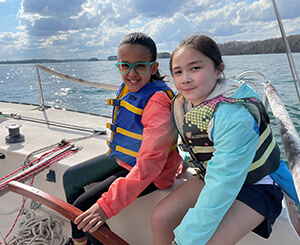
Two girls sailing on Poppi’s Pride III learning how sail power works.
Enter the University Yacht Club Maritime Foundation. UYC member Edith Collins, who is also a US Sailing Judge and life-long sailor, learned about the project through a former neighbor who teaches at Sharon Elementary. Collins connected the group to the UYC Maritime Foundation.
“We have a sailing fleet at UYC and our members often take out students from our Junior Sailing Camp, so I asked Wayne Flanagan, the Maritime Foundation Chair, for assistance,” Collins said. “He was glad to help and within a couple of days, we had boats and skippers volunteering and had picked a date.”
For Wing and her students, it was a chance to see on-paper concepts in practice. The Maritime Foundation provided life jackets; the students had a quick land-school briefing to talk about sailing principles and then headed to the sailboats.
Four skippers, Dale Owens, Kent Rogers, Rick Smith and Rick Fulgham, took 2 or 3 students, plus each boat had an adviser and/or a parent aboard. The skippers gave the students a chance to steer the boats while explaining how to spot the wind on the water and how to navigate from one point to another using sail direction.
“It was a chance for the kids to get involved, from steering to actually helping read the tell-tales and experience why boats can’t sail directly into the wind,” Collins said. “A couple of them just blew us away with their natural understanding about how boats go.”
The participants and parents gathered at the club after the afternoon sail for hot dogs and refreshments, sponsored by the UYC Maritime Foundation.
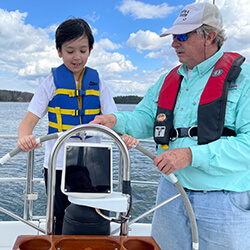
Rick Smith explains to STEM student how the wheel works.
“One of the main missions of the UYC Maritime Foundation is marine education,” Flanagan said. “In addition to sponsoring our Junior Sailing Program each summer, we offer high school scholarships and support other community endeavors. We are happy when we can work in the community to support students.”
More about STEM
Graduates with computer programming and coding skills are in demand. According to iSTEMnetwork.org STEM jobs are increasing at a higher rate than non-STEM jobs. Teaching critical thinking and problem solving, STEM education leads to higher-paying careers, leadership skills and teamwork to meet their goals. Groups supporting girls and young women in STEM proliferate, as do other culturally and ethnically diverse populations.
Across the US and globally, FIRST LEGO League has created a series of programs to accelerate STEM learning. Young students begin to understand the language of mathematics, science and technology in Pre-K classes.
“Teaching STEM subjects carries with it real-world applications, many that are accessed by understanding gaming concepts,” Wing said. “It makes education relevant and at the same time has obvious returns. When students succeed in building and programming a robot, it can be instantly rewarding, and spurs them to ask, ‘what’s next?’ It keeps them engaged and motivated.”
Perhaps Collins said it best: “The sport of sailing has many benefits from just having an enjoyable day on the water to being able to understand what makes a boat go,” she said. “Some people simply like to sail; others race; and still others really get their heads wrapped around the principles. Sailing is also about teamwork and cooperation, concepts that make us all better humans.”
Wing takes it one step further.
“Today’s youngsters are facing more competition for college and technical school admission, career choices and real-life challenges,” she said. “To be able to learn these principles at a young age really sets the bar high for the rest of their lives.
“Our school, the staff, faculty, parents and students, have been amazed by the generous support of our team as we embark on more STEM studies and programs,” Wing said. “It is so inspiring when we see people like the UYC Maritime Foundation, people who don’t even know us, share their knowledge and resources with us as we continue this journey to the international championships. Not only does it give our students another perspective on learning, it shows them that people are kind and generous.”
How you can help the kids
The team wants to share its solution with as many people as possible. The students created a YouTube Channel, SRK X-Wing, to share their solution and need people to subscribe and like it. You can see their innovation project presentation on the YouTube channel.
Photos: by Pamela A. Keene except for Robotics photo at top by Sharq Photography

